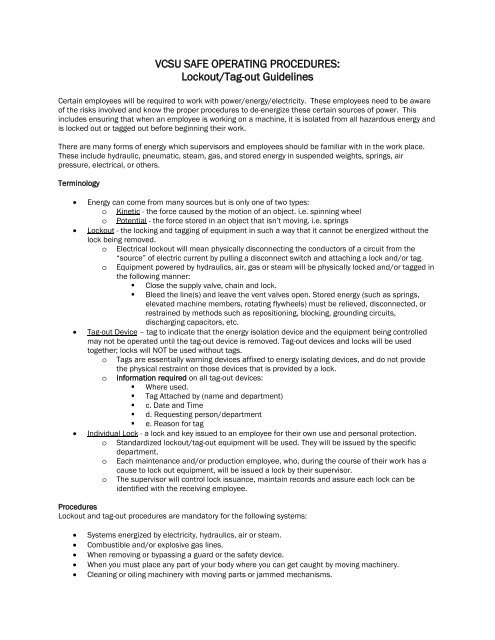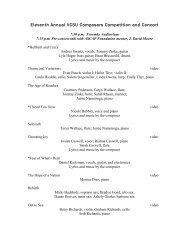Lockout/Tag-out Guidelines
Lockout/Tag-out Guidelines
Lockout/Tag-out Guidelines
You also want an ePaper? Increase the reach of your titles
YUMPU automatically turns print PDFs into web optimized ePapers that Google loves.
VCSU SAFE OPERATING PROCEDURES:<br />
<strong>Lock<strong>out</strong></strong>/<strong>Tag</strong>-<strong>out</strong> <strong>Guidelines</strong><br />
Certain employees will be required to work with power/energy/electricity. These employees need to be aware<br />
of the risks involved and know the proper procedures to de-energize these certain sources of power. This<br />
includes ensuring that when an employee is working on a machine, it is isolated from all hazardous energy and<br />
is locked <strong>out</strong> or tagged <strong>out</strong> before beginning their work.<br />
There are many forms of energy which supervisors and employees should be familiar with in the work place.<br />
These include hydraulic, pneumatic, steam, gas, and stored energy in suspended weights, springs, air<br />
pressure, electrical, or others.<br />
Terminology<br />
• Energy can come from many sources but is only one of two types:<br />
o Kinetic - the force caused by the motion of an object. i.e. spinning wheel<br />
o Potential - the force stored in an object that isn’t moving. i.e. springs<br />
• <strong>Lock<strong>out</strong></strong> - the locking and tagging of equipment in such a way that it cannot be energized with<strong>out</strong> the<br />
lock being removed.<br />
o Electrical lock<strong>out</strong> will mean physically disconnecting the conductors of a circuit from the<br />
“source” of electric current by pulling a disconnect switch and attaching a lock and/or tag.<br />
o Equipment powered by hydraulics, air, gas or steam will be physically locked and/or tagged in<br />
the following manner:<br />
Close the supply valve, chain and lock.<br />
Bleed the line(s) and leave the vent valves open. Stored energy (such as springs,<br />
elevated machine members, rotating flywheels) must be relieved, disconnected, or<br />
restrained by methods such as repositioning, blocking, grounding circuits,<br />
discharging capacitors, etc.<br />
• <strong>Tag</strong>-<strong>out</strong> Device – tag to indicate that the energy isolation device and the equipment being controlled<br />
may not be operated until the tag-<strong>out</strong> device is removed. <strong>Tag</strong>-<strong>out</strong> devices and locks will be used<br />
together; locks will NOT be used with<strong>out</strong> tags.<br />
o <strong>Tag</strong>s are essentially warning devices affixed to energy isolating devices, and do not provide<br />
the physical restraint on those devices that is provided by a lock.<br />
o Information required on all tag-<strong>out</strong> devices:<br />
Where used.<br />
<strong>Tag</strong> Attached by (name and department)<br />
c. Date and Time<br />
d. Requesting person/department<br />
e. Reason for tag<br />
• Individual Lock - a lock and key issued to an employee for their own use and personal protection.<br />
o Standardized lock<strong>out</strong>/tag-<strong>out</strong> equipment will be used. They will be issued by the specific<br />
department.<br />
o Each maintenance and/or production employee, who, during the course of their work has a<br />
cause to lock <strong>out</strong> equipment, will be issued a lock by their supervisor.<br />
o The supervisor will control lock issuance, maintain records and assure each lock can be<br />
identified with the receiving employee.<br />
Procedures<br />
<strong>Lock<strong>out</strong></strong> and tag-<strong>out</strong> procedures are mandatory for the following systems:<br />
• Systems energized by electricity, hydraulics, air or steam.<br />
• Combustible and/or explosive gas lines.<br />
• When removing or bypassing a guard or the safety device.<br />
• When you must place any part of your body where you can get caught by moving machinery.<br />
• Cleaning or oiling machinery with moving parts or jammed mechanisms.
• The operation of a piece of equipment may cause damage to that equipment.<br />
• When it is to prevent the unauthorized use of equipment.<br />
<strong>Lock<strong>out</strong></strong><br />
The authorized employee will know the type and magnitude of energy that the machine or equipment uses and<br />
will understand the hazards involved:<br />
• <strong>Lock<strong>out</strong></strong> and tag-<strong>out</strong> will be performed only by the authorized<br />
• Notify all affected employees that a lock<strong>out</strong> or tag-<strong>out</strong> system is going to be utilized and the reason.<br />
• Turn off the equipment by the normal stopping procedure, and disconnect all energy sources by<br />
pulling the plug, breaking the circuit, closing the valve, pulling the fuse or flipping the main switch.<br />
• The lock<strong>out</strong> will be made at the energy source by the employee performing the job. Isolate the primary<br />
and secondary energy sources.<br />
• Each person who works on a “Locked Out” piece of equipment will place his/her lock and tag on the<br />
equipment. No individual or department will work under another individual/department’s lock and tag.<br />
• When there is doubt as to the location of the proper disconnect switch or valve to lock <strong>out</strong>, the<br />
Electrician/ Department Supervisor will be contacted to oversee the proper de-energizing of the<br />
system or equipment.<br />
o If it is not possible to “physically” lock<strong>out</strong> equipment due to age or design, one of the following<br />
will apply:<br />
A security device will be attached to the system to lock it <strong>out</strong>.<br />
The energy supply will be physically disconnected and danger tags placed in strategic<br />
locations to notify all people in the area that the equipment is being worked on.<br />
An employee of the same department, who is properly instructed in lock<strong>out</strong>/tag-<strong>out</strong><br />
safety, will ensure the equipment is not inadvertently energized.<br />
Try<strong>out</strong><br />
After locking <strong>out</strong> and tagging <strong>out</strong> the switch or switches, the individual or department performing the work will<br />
attempt to operate the equipment before beginning work on the equipment.<br />
• The person trying the equipment will test it by pushing the start buttons or other controls to make<br />
certain the equipment will not run.<br />
• Return the operating control(s) to “neutral” or “off” position after the test.<br />
• The equipment is now locked <strong>out</strong> and tagged <strong>out</strong>.<br />
• If the equipment DOES energize, push the stop button and contact your supervisor immediately for<br />
further instruction.<br />
Restoring Normal Operation - Removal of Locks/<strong>Tag</strong>s<br />
• Prior to restoring normal operations, prepare and check the area around the machine or equipment to<br />
ensure that no one is exposed to hazards or injury.<br />
• After all tools have been removed from the machine or equipment, guards reinstalled and employees<br />
notified, remove all lock<strong>out</strong> or tag-<strong>out</strong> devices.<br />
• Each person will remove his/her own lock and tag. It will be a safety violation to remove another<br />
person’s lock and tag.<br />
• Disengage the energy isolating devices to restore energy to the machine or equipment. 5. When an<br />
employee has left his/her lock and tag on for an unknown reason, and it has to be removed, the<br />
following will be applied:<br />
o If the employee is in the building, he/she will remove the lock and tab.<br />
o If the employee has left the building, every effort will be made to contact the employee for<br />
reasons of leaving the lock and tag in place.<br />
o If the employee cannot be located, their department supervisor, along with a member of the<br />
same department, must check <strong>out</strong> the equipment and make sure it is safe to remove the lock<br />
and tag.<br />
Contractors
The contractor assigned to the project will follow the procedures <strong>out</strong>lined in the lock<strong>out</strong> and tag-<strong>out</strong> guidelines.<br />
• The contractor will use the locks and tags specific to their company.<br />
• The contractor will be responsible for removing their own locks and tags when the work is completed.<br />
Training<br />
Training will be provided for the purpose and function of the energy control guidelines.<br />
• Appropriate employees will be provided training by their departmental supervisors in the safety<br />
procedures used for lock<strong>out</strong>/tag-<strong>out</strong>.<br />
• Each new or transferred employee or those, whose work operations are or may be in the area, will be<br />
instructed in the purpose and use of the lock<strong>out</strong>/tag-<strong>out</strong> procedures.<br />
• Retraining will be provided for all authorized and affected employees whenever there is a change in<br />
machines, equipment or processes that present a new hazard, or when there is a change in the energy<br />
control procedures.




